| Article ID | Journal | Published Year | Pages | File Type |
|---|---|---|---|---|
| 149441 | Chemical Engineering Journal | 2012 | 5 Pages |
As micro reactors are more and more used in research and production, the need for micro work-up facilities like separators for organic and aqueous slug flow is growing. Numerous examples of these capillary force based separators are presented in literature. The disadvantage of these devices is that at higher flow rates, the hydraulic pressure exceeds the capillary pressure which results in breakthrough. In this paper we present a micro separator for liquid–liquid slug flow with hydrophobic and hydrophilic rectangular capillaries (height: 0.1–2 mm, length: 5 mm and width: 10 mm) to prevent this. The narrow height of the capillary provides a large capillary pressure and the large width a low hydraulic pressure. Separation efficiencies of 99.5% for flow rates of 30–50 ml min−1 are obtained. The ratio between the capillary pressure and the hydraulic pressure is a good predictor of the separation efficiency and must have the value 2 or higher to prevent breakthrough.
• A micro slug flow separator consisting of slit shaped capillaries is tested. • The height of the Teflon and glass slit shaped capillaries ranges from 0.1 to 2 mm. • The capillary pressure in the slits corresponds to the Young–Laplace equation. • The hydraulic pressure in the slits corresponds to the Hagen–Poiseuille equation. • Water–n-heptane slug flow was separated for a total flow rate up to 50 ml min−1.
